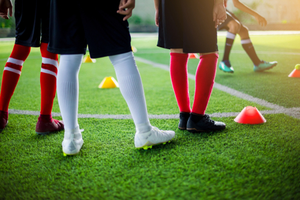What Are The Dangers of Playing on Artificial Turf?

Are Athletes at Risk on Artificial Turf?
School boards and recreation departments prefer children from pre-K to college play sports on artificial turf. If you ask a parent what surface they prefer, you will find that they are playing on a completely different team.
Artificial turf is made of backing material to hold the individual blades of grass, plastic blades of grass, and infill, which are the tiny black crumbs that help support the blades.
So, What’s the Problem?
The infill.
Various pigments are used to provide the green color to the blades to make them look natural and can include lead, titanium, and other metals for on-field logos. Lead is a known neurotoxin that can harm both developing (young athletes) and mature nerve tissue.
Little black crumbs support the blades and are made from tires, which are a mixture of natural and synthetic rubber and carbon black. Modern tires are also made with anywhere between four and ten gallons of petroleum products. Also, the tires are exposed to other chemicals (like dibenzoprynes) prior to being in the turf, which the turf can then absorb. Dibenzoprynes is a known carcinogen, and carcinogenic chemicals can promote the formation of cancer.
While the tire crumbs start out as larger pieces, they breakdown over time due to excessive use and weather conditions. Dr. Stuart Shalat, Professor and Director of the Division of Environmental Health, School of Public Health, Georgia State University, conducted a study that showed that the tiny particles from the turf could be suspended in the air and inhaled or swallowed by the athletes on the field.
Additionally, though artificial turf does not need to be mowed, crabgrass and other weeds can grow from it. To keep the artificial turf looking its best, weedkillers are applied. One of those weedkillers is Roundup, which includes glyphosate. Studies have linked glyphosate to lymphoma.
Laying Down the Law
On July 16, 2010, Attorney General Edmund G. Brown Jr. announced a settlement that required two of the largest artificial turf makers and installers to eliminate nearly all lead from their products.
The two companies were Beulieu, LLC, a supplier of artificial turfs to retailers, and Field Turf, USA, a maker and installer of artificial turf friends. The settlement required that the companies update their products to contain less than 50 parts lead per million. There were lab results that found some products contained more than 5,000 parts lead per million, which was more than ten times the state and federal guidelines for content in children’s products.
In March 2019, Monsanto, maker of Roundup weed killer, was ordered to pay over $80 million in compensatory and punitive damages to a plaintiff that suffered non-Hodgkins lymphoma from the use of Roundup and its glyphosate ingredient.
Digging Deeper
The link between cancer and artificial turf gained national attention when NBC’s Nightline News put out a series of news stories regarding a possible cluster of cancers in young women soccer players. A cancer cluster is the appearance of an unusually high rate of cancer in one location in a particular time frame.
In 2009, associate head coach for the University of Washington’s women’s soccer team Amy Griffin spent time visiting women and other athletes in local hospitals. During that time, she and a nurse noticed a trend – a lot of the players that were going through chemotherapy were goalies. Griffin compiled a list of 38 American soccer players who were diagnosed with cancer, 34 of which were goalies. To this day, she continues to push for and speak out on the potential dangers of artificial turf.
Verdict
Before 2016, limited studies were done on the safety of recycled rubber tire crumb used in synthetic turf fields and playgrounds in the United States. The concerns raised by the public about these potential dangers led to a multi-agency Federal Research Action Plan on Recycled Tire Crumb Used on Playing Fields and Playgrounds to study key environmental and human health questions. According to the EPA, their report is now undergoing peer review.
While there is no conclusive evidence yet, it doesn’t hurt to protect yourself and your children should you find yourselves on artificial turf. Some tips include:
- Use organic and glyphosate-free weed killers, or make a DIY solution with vinegar, salt, and dish soap, on artificial turf
- Take your children to playgrounds with natural turf and sign them up for sports leagues that play on natural turf
- Always wash hands after playing on the field
- Take off shoes to avoid bringing rubber into the house
- Shower after playing
- Clean all cuts and scrapes
- Avoid swallowing crumb rubber
By the Numbers
- There are more than 13,000 synthetic turf sports fields in the U.S., with approximately 1,200-1,500 new installations each year.
- Since 2003, over 70 FIFA U-17 and U-20 World Cup Matches have been played on synthetic turf soccer fields.
- By the end of 2014, there were 40-45 million square feet of synthetic grass installed in the U.S.
- In 2019, 12 NFL teams played on artificial turf, while the remaining 19 played on natural turf fields
- As of March 28, 2019, there were over 11,000 cases in multi-district litigation in which the plaintiff allegedly sustained non-Hodgkins lymphoma due to repeated exposure to Roundup.
Are Athletes at Risk on Artificial Turf? - Infographic
Sources:
- https://www.cnn.com/2017/01/27/health/artificial-turf-cancer-study-profile/
- https://www.cancer.org/cancer/cancer-causes/general-info/known-and-probable-human-carcinogens.html
- https://www.washingtonpost.com/national/health-science/does-playing-on-artificial-turf-pose-a-health-risk-for-your-child/2017/03/17/0c61b7b4-0380-11e7-ad5b-d22680e18d10_story.html?utm_term=.7d9799ea84e0
- https://theconversation.com/why-artificial-turf-may-truly-be-bad-for-kids-72044
- https://www.lawnstarter.com/blog/sports-turf/nfl-mlb-teams-artificial-turf-2019/
 Moll Law Group Home
Moll Law Group Home